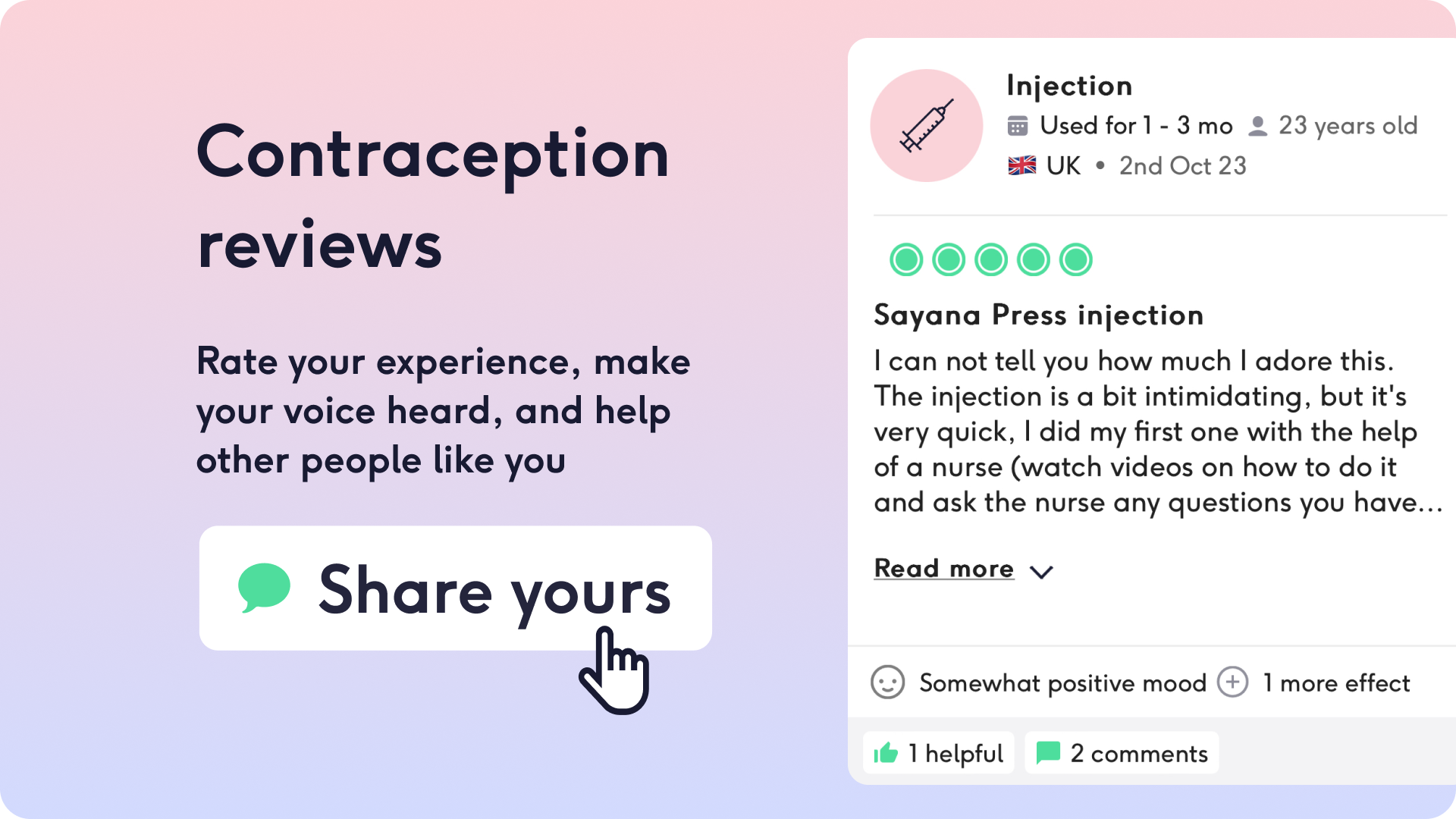
Using contraception can be like a long-term relationship; with so many different options, it’s only natural to be curious about what else might be out there. There is a wide array of available methods designed to meet the needs of different women.
Every woman is different and just because your contraception may be working doesn’t necessarily mean it’s working for you.
TL;DR… What’s the lowdown?
- The safest way to change your contraception is under the guidance of a medical professional – your healthcare provider should be happy to answer any questions or address any concerns you may have
- Switching your method of contraception requires time and planning
- If you ever find yourself in doubt, use extra protection such as condoms which are accessible in many supermarkets and pharmacies, and are often available free of charge at sexual health clinics
- When switching to any new method some side effects may occur – taking care of yourself with light exercise, healthy eating and pain relievers may help to alleviate some of these symptoms
Why should you change contraception?
There are a number of reasons why someone might decide to try a new form of contraception.
Side effects
Some women may experience adverse side effects whilst using a specific form of contraception. These adverse symptoms may be physical or emotional and typically include acne, weight gain, headaches, breast tenderness, irregular bleeding, painful periods, depressed or anxious mood, or other complaints.
Reliability
Women may also make a switch for reasons of reliability, ease of use, or control of bleeding patterns. For example, a woman may decide to switch to an IUS (also known as the intrauterine system or hormonal coil) if she finds herself forgetting to take the pill some days. But just to be clear, there is absolutely no necessity to change your form of contraception if you are happy with it or you think the benefits outweigh any downsides.
One thing to note is that it usually takes your body 3 to 6 months to adjust to a new method of contraception. For some women this adjustment can be accompanied by uncomfortable side effects, similar to those above. If you’re still experiencing unwanted or unmanageable side effects after this amount of time, it may be time to speak to your healthcare provider about how to manage these or consider making a switch. And, of course, If you do experience any side-effects you are concerned about before the 3 to 6 month mark, reach out to your healthcare provider.
If you have read this far and are still interested in potentially trying out a new form of contraception, here is your go-to guide for what to expect when switching contraception.
What to consider when changing contraception
There are some logistics to consider when switching your form of contraception from one method to another. Timing is a key factor and the reality is it may take some time to actually make the switch. Most contraception requires a prescription, acquired either during a visit to your GP or from a sexual health clinic, both of which may require an appointment.
The impact of Covid
The coronavirus pandemic has made things even more difficult. You may be thinking “you’re telling me this virus is affecting my sexual health too?!” Unfortunately, it may be. If you’re considering switching, you may need to be proactive and plan ahead. Restrictions around face-to-face appointments may delay your access to different forms of contraception which require an in-person fitting or removal, such as an IUS or the implant.
Data from NHS digital showed that between April and September 2020 44% of sexual health clinic appointments were non-face to face compared to only 3% the year before, and fewer women were getting methods such as the coils, implant or injection.
Check with your provider if virtual appointments are an option. If certain clinical measurements, such as blood pressure and weight, are up to date and stable, it may be possible to issue an electronic prescription to your pharmacy for the combined pill, patch or ring. Switching brands of the combined pill may also therefore be possible following a virtual appointment. If a face-to-face consultation is necessary you may be invited for one. If this is not possible, you may be offered an alternative, such as the progestogen-only pills, until you are able to make an appointment with your provider in person. You can buy mini pills including Hana, Aizea, Cerazette and more a the Lowdown (you’ll need to fill in a few questions first!).
Beginning most forms of contraception, such as the pill or the patch, do not require any downtime after. However, an IUS or the implant requires a physical insertion or placement, which may be accompanied by some immediate short-term side effects and is a factor to consider when planning your switch. For IUS insertion, the most common immediate side effect is uterine cramping, with around 65% of our reviewers reporting pain. Similarly, tenderness or slight bruising has been reported following insertion of the implant. Every woman will have a different experience and it is important to listen to your body and do what feels best for you, even if this means taking the rest of the day a little more slowly than usual.
How to switch from one method of contraception to another
When considering making a switch, we recommend speaking to your healthcare provider. These switches are all about timing and trying to figure out how best to switch between different methods can be confusing.
There are, indeed, correct ways to transition from one method of contraception to another, (depending on which methods you want to switch between and how reliably you’ve been using them) and doing so incorrectly may increase your risk for unplanned pregnancy so it’s best to discuss this with a healthcare professional.
How long does it take to adjust to a new contraception?
For most switches, barrier methods are used to maintain contraceptive cover to protect a woman from unintended pregnancy. This is because your new contraception may need some time to be able to provide its full protective effects. Most commonly this means using condoms during sex after beginning your new form of contraception, until you can rely on it for contraceptive cover.
Ensuring you use your existing contraception method correctly and consistently before you switch is also important. For example, there is no need for extra protection when switching to a new brand of pill immediately after completing the entirety of the old pack, with no gaps in between. However, when switching from the combined pill to an IUS you may be advised you need to use extra protection such as condoms for 7 days after the IUS is fitted, depending on where in your pill pack you are.
You should reach out to either your GP or your local sexual health clinic to help guide you on your contraception-changing journey or chat to one of The Lowdown’s specialist doctors for contraception advice.
Contraception is still available free on the NHS, however, remember that COVID-19 restrictions may delay the transition, so speak to your healthcare provider about your options.
Tags
- The Lowdown. Common contraceptive implant side effects. 2020.
- The Lowdown. Our most popular contraceptives IUS vs combination pill. 2021.
- NHS Digital. Sexual and Reproductive Health Services, England (Contraception) April – September 2020 (provisional statistics). March 2021.
- Faculty of Sexual and Reproductive Health. FSRH Guidance: Switching or Starting Methods of Contraception. March 2021
- NHS UK website. Contraception.
- NHS UK website. Combined contraceptive pill.
- Lesnewski R et al. Preventing gaps when switching contraceptives. Am Fam Physician. 2011.
- Elizabeth Arveda Kissling (2013) Pills, Periods, and Postfeminism, Feminist Media Studies, 13:3, 490-504, DOI: 10.1080/14680777.2012.712373
- Schramm G, Heckes B. Switching hormonal contraceptives to a chlormadinone acetate-containing oral contraceptive. The Contraceptive Switch Study. Contraception. 2007. https://doi.org/10.1016/j.contraception.2007.03.014
- Ferreira J et al. Reasons for Brazilian women to switch from different contraceptives to long-acting reversible contraceptives. Contraception. 2013. :https://doi.org/10.1016/j.contraception.2013.09.012
- Wellings K et al. Stopping and switching contraceptive methods: findings from Contessa, a prospective longitudinal study of women of reproductive age in England. Contraception. 2007. https://doi.org/10.1016/j.contraception.2007.03.014
Erin is an Associate Account Executive at BGB Group in New York City. She studied in London and has her MSc in Clinical and Public Health Nutrition from UCL. She has a particular passion for using nutrition for disease prevention, as well as women’s health.
You can find Erin on LinkedIn here.










